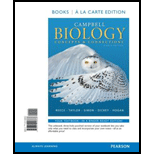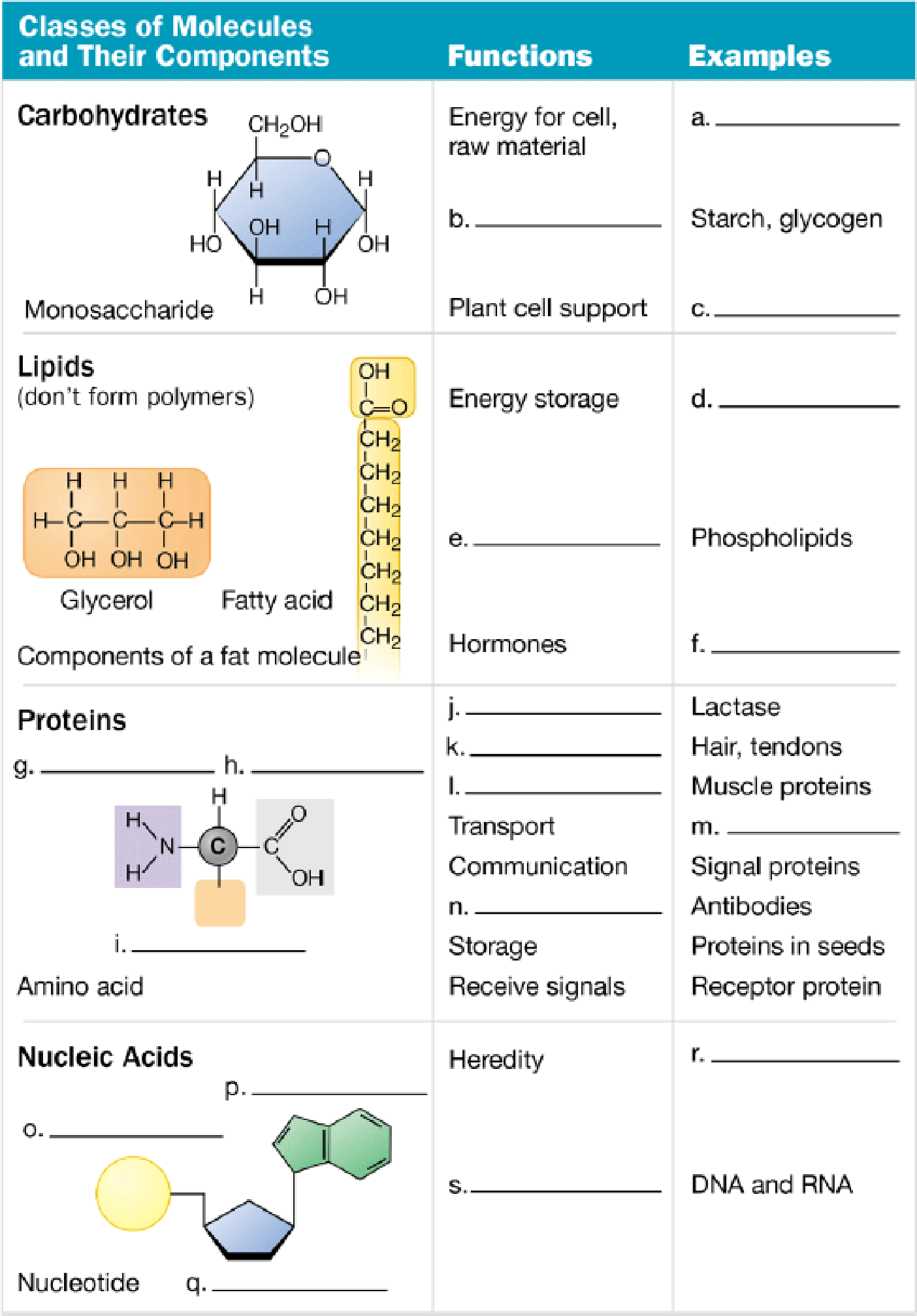
Concept explainers
Complete the following table to help you review the structures and functions of the four classes of organic molecules.

To create: The concept map to review the structures and functions of the four classes of organic molecules.
Introduction: The four classes of molecules such as carbohydrates, lipids, proteins, and nucleic acids are important to sustain the life. Carbohydrates serve as a fuel and building material for cellsand tissues. Lipid comprises a diverse group of molecules. It does not mix with water. A protein is a polymer of amino acids. It is structurally and functionally most complex and varied. Nucleic acid is the genetic material that consists of a polynucleotide.
Answer to Problem 1CC
Pictorial representation: Fig. 1 shows the completed concept map of structures and functions of the four classes of organic molecules.

Fig.1: Concept map of the structures and functions of the four classes of organic molecules.
Explanation of Solution
a.
Correct answer: Glucose
Explanation: Glucose is the raw material from which cell will get energy. Hence, the correct answer is Glucose.
b.
Correct answer: Energy storage
Explanation: The starch and glycogen is used as storage material of energy. Hence, the correct answer is energy storage.
c.
Correct answer: Cellulose
Explanation: Cellulose is polysaccharides which is a polymer of glucose molecule. Hence, the correct answer is cellulose.
d.
Correct answer: Fats
Explanation: Fats are a type of lipid. It is composed of glycerol and fatty acids. Hence, the correct answer is fats.
e.
Correct answer: Cell membrane component
Explanation: Cell is the outermost boundary of animal cell. It is made of phospholipid bilayer. Hence, the correct answer is cell membrane component.
f.
Correct answer: Steroids
Explanation: Steroids are hormones such as estrogen. Hence, the correct answer is steroids.
g.
Correct answer: Amino group
Explanation: Protein is made of amino acids. An amino acid contains amino group which is
h.
Correct answer: Carboxylic group
Explanation: Protein is made of amino acids. An amino acid contains carboxylic group which is
i.
Correct answer: R group
Explanation: Protein is made of amino acids. An amino acid contains a side group which is called R group. Hence, the correct answer is R group.
j.
Correct answer: Enzyme
Explanation: Proteins have broad functions such as enzymes, structural proteins, transport, movement, defense, and storage. Lactase is an enzyme used for breakdown of lactose molecule. Hence, the correct answer is Enzyme.
k.
Correct answer: Structural proteins
Explanation: Proteins have broad functions such as enzymes, structural proteins, transport, movement, defense, and storage. Hair and tendons are structural proteins. Hence, the correct answer is structural proteins.
l.
Correct answer: Movement
Explanation: Muscle is a protein that helps in movement. Hence, the correct answer is movement.
m.
Correct answer: Membrane transport protein
Explanation: Membrane transport protein helps in transport of different molecules across the membrane. Hence, the correct answer is Membrane transport protein.
n.
Correct answer: Defense
Explanation: Signal protein helps in communication. Antibodies are immunoglobulin protein that helps in body defense. Hence, the correct answer is defense.
o.
Correct answer: Phosphate group
Explanation: Nucleic acid is a polymer of nucleotides. A nucleotide consists of phosphate group, sugar and nitrogenous base. Hence, the correct answer is phosphate group.
p.
Correct answer: Nitrogenous base
Explanation: Nucleic acid is a polymer of nucleotides. A nucleotide consists of phosphate group, sugar and nitrogenous base. Hence, the correct answer is nitrogenous base.
q.
Correct answer: Ribose or deoxyribose
Explanation: Nucleic acid is a polymer of nucleotides. A nucleotide consists of phosphate group, sugar (ribose or deoxyribose) and nitrogenous base. Hence, the correct answer is ribose or deoxyribose.
r.
Correct answer: DNA
Explanation: Nucleic acid is a polymer of nucleotides. DNA (deoxyribonucleic acid) is the hereditary material. Hence, the correct answer is DNA.
s.
Correct answer: Code for protein
Explanation: Nucleic acid is a polymer of nucleotides. DNA and RNA have information to code for protein. Hence, the correct answer is code for protein.
Want to see more full solutions like this?
Chapter 3 Solutions
Campbell Biology: Concepts & Connections, Books a la Carte Plus Mastering Biology with eText -- Access Card Package (8th Edition)
- In the learning process of biochemistry, we find that many biomolecules have helical structure. Please give two specific examples and introduce their structure in detailarrow_forwardConsider the amino acid valine. Note: Reference the Naturally-occurring amino acids table for additional information. Part: 0/4 Part 1 of 4 Draw the neutral form of the amino acid. Click and drag to start drawing a structure.arrow_forwardOrganize the following words into a diagram. Please, make sure to use all the words given to form a diagram. Derived, saturated, unsaturated, functions, structures, lipids, signaling molecules, triglycerides, phospholipids, glycolipids, sphingosine, stearic acidarrow_forward
- Consider the tripeptide serylalanylleucine. Part: 0 / 2 Part 1 of 2 Draw the structure of this tripeptide at physiological pH. Click and drag to start drawing a structure.arrow_forwardPlace the following components in order from least to most complex (atom, proton, starch, glucose, hydroxyl grouparrow_forwardCompare and contrast the 4 biomolecules structurally . Determine the properties and functions for each .arrow_forward
- name the class of large biological molecule for the following molecule. circle & label an example of each of 6 different functional groups on the molecule below. CH3 OH CH3arrow_forwardHighlight each glycosidic bond in the molecule below. Then answer the questions in the table under the drawing area. HO-CH, H но Но HO–CH, H H ОН Н H ОН ن H H ОН Н ОН ОН H CH, H ОН H H ОН H но-сн, Н H ОН H он H ОН ОНarrow_forwardIn a tabulated form enumerate and draw the functional groups, give examples of biological compound having this functional group and identify its biochemical importance Functional Groups and Structure Examples Biological compound and its structure Biological Importancearrow_forward
- Before we finish this part of the Activity, you’re going to begin summarizing what you’ve learned using a graphic organizer. In this part there were 4 terms highlighted. These are all terms to describe biological molecules. We will learn more in the coming Activities. For now, organize them in the way that makes most sense for you. Include details from this Activity as you use vocabulary related to biochemistry to describe biological molecules. functional group polarity intermolecular forces of attraction hydrogen bonarrow_forwardConsider the amino acid leucine. Note: Reference the Naturally-occurring amino acids table for additional information. Part: 0 / 4 Part 1 of 4 Draw the neutral form of the amino acid. Click and drag to start drawing a structure.arrow_forwardIn studying a particular biomolecule (protein, nucleic acid, carbohydrate, lipid), a biochemist needs to separate/ purify it from other biomolecules in the sample. However, looking at the monomeric subunits of a biomolecule, one should have an idea about the characteristics of the molecule that would allow to separate/purify it from other molecules. On what basis can you separate: a. amino acids from fatty acids? b. nucleotides from glucose?arrow_forward
 Biology Today and Tomorrow without Physiology (Mi...BiologyISBN:9781305117396Author:Cecie Starr, Christine Evers, Lisa StarrPublisher:Cengage Learning
Biology Today and Tomorrow without Physiology (Mi...BiologyISBN:9781305117396Author:Cecie Starr, Christine Evers, Lisa StarrPublisher:Cengage Learning
